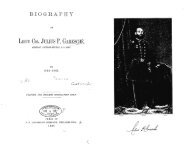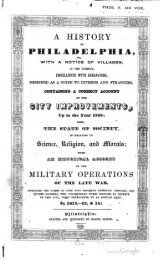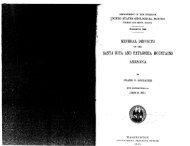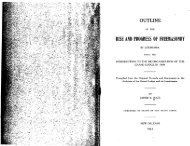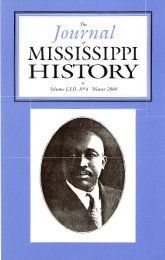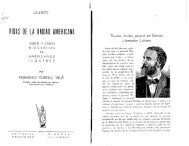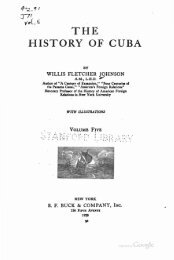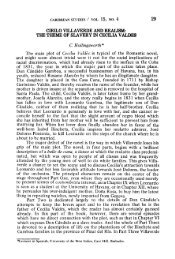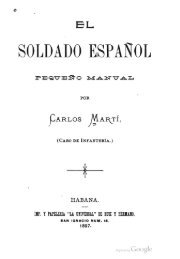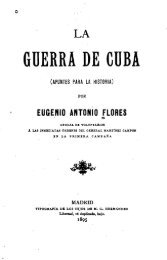Areas and Periods of Culture in the Greater Antilles
Areas and Periods of Culture in the Greater Antilles
Areas and Periods of Culture in the Greater Antilles
Create successful ePaper yourself
Turn your PDF publications into a flip-book with our unique Google optimized e-Paper software.
250<br />
SOUTHWESTERN JOURNAL OF ANTHROPOLOGY<br />
Vieques, an islet <strong>of</strong>f <strong>the</strong> east coast <strong>of</strong> Puerto Rico, whence <strong>the</strong>y conducted periodic<br />
raids on <strong>the</strong> Arawak <strong>of</strong> <strong>the</strong> larger isl<strong>and</strong>s, far<strong>the</strong>r west.9<br />
It is generally agreed that <strong>the</strong> Ciboney were <strong>the</strong> first to settle <strong>the</strong> West Indies,<br />
but whe<strong>the</strong>r <strong>the</strong>y orig<strong>in</strong>ally came from North America, as seems likely to us, is<br />
still a matter for dispute.10 The Arawak arrived next, migrat<strong>in</strong>g from South<br />
America by way <strong>of</strong> <strong>the</strong> Lesser <strong>Antilles</strong> <strong>and</strong> driv<strong>in</strong>g <strong>the</strong> Ciboney back <strong>in</strong>to <strong>the</strong><br />
peripheral positions <strong>in</strong> which <strong>the</strong>y were found by <strong>the</strong> Spaniards.11 The Carib were<br />
<strong>the</strong> last to move <strong>in</strong>, aga<strong>in</strong> from <strong>the</strong> South American ma<strong>in</strong>l<strong>and</strong>. To judge from <strong>the</strong><br />
Indian traditions, <strong>the</strong>y took over <strong>the</strong> Lesser <strong>Antilles</strong> from <strong>the</strong> Arawak shortly<br />
before <strong>the</strong> arrival <strong>of</strong> Columbus.12<br />
SPACE AND TIME SCALES<br />
For <strong>the</strong> purpose <strong>of</strong> survey<strong>in</strong>g <strong>the</strong> archaeology, it will be convenient to divide<br />
<strong>the</strong> <strong>Greater</strong> <strong>Antilles</strong> <strong>in</strong>to a series <strong>of</strong> geographical units, which are represented by<br />
<strong>the</strong> vertical columns <strong>in</strong> <strong>the</strong> body <strong>of</strong> <strong>the</strong> accompany<strong>in</strong>g chart (Fig. 2). From west<br />
to east, <strong>the</strong>se <strong>in</strong>clude: (1) western Cuba, (2) central Cuba, (3) eastern Cuba,<br />
(4) Jamaica, (5) <strong>the</strong> Turks <strong>and</strong> Caicos Isl<strong>and</strong>s, (6) Haiti, (7) <strong>the</strong> Dom<strong>in</strong>ican<br />
Republic, (8) <strong>the</strong> western half <strong>of</strong> Puerto Rico, (9) eastern Puerto Rico, <strong>and</strong><br />
(10) <strong>the</strong> Virg<strong>in</strong> Isl<strong>and</strong>s. The Bahamas colony, north <strong>of</strong> Cuba <strong>and</strong> northwest <strong>of</strong><br />
<strong>the</strong> Turks <strong>and</strong> Caicos Isl<strong>and</strong>s, has been omitted because so little is known <strong>of</strong> its<br />
archaeology.<br />
These particular units have been selected because <strong>the</strong>y are <strong>the</strong> largest regions<br />
which appear to have been geographically homogeneous <strong>in</strong> culture dur<strong>in</strong>g each<br />
successive period <strong>of</strong> prehistory. Never<strong>the</strong>less, <strong>the</strong>y should not be considered<br />
culture areas, but, ra<strong>the</strong>r, segments <strong>the</strong>re<strong>of</strong>. In order to form areas, we have had<br />
to proceed period by period <strong>and</strong> to comb<strong>in</strong>e those units which are similar <strong>in</strong><br />
culture. As will be shown, <strong>the</strong> comb<strong>in</strong>ations vary from period to period.<br />
Seven arbitrary periods <strong>of</strong> time, comparable to <strong>the</strong> units <strong>of</strong> space, have been<br />
recognized <strong>in</strong> <strong>the</strong> <strong>Greater</strong> <strong>Antilles</strong>. They comprise <strong>the</strong> horizontal columns <strong>in</strong><br />
Figure 2, where <strong>the</strong>y are numbered I, IIa, IIb, IIIa, IIIb, IVa, <strong>and</strong> IVb. The<br />
9 Ober, 1895; Joyce, 1916; Rouse, 1948, pp. 547-565; Taylor, 1949. The last disagrees<br />
with several <strong>of</strong> <strong>the</strong> above statements, particularly that <strong>the</strong> Carib relied so much on sea food.<br />
10 Rouse, 1949. For <strong>the</strong> alternative <strong>the</strong>ory, that <strong>the</strong> Ciboney migrated from South America,<br />
see Harr<strong>in</strong>gton (1921, vol. 2, pp. 424-426) <strong>and</strong> Herrera Fritot (1943, p. 268).<br />
11 Osgood, 1942; Rouise, 1947b.<br />
12 Gower, 1927; Loven, 1935, pp. 51-53. Disagree<strong>in</strong>g with <strong>the</strong> latter's <strong>in</strong>terpretation <strong>of</strong> <strong>the</strong><br />
documentary evidence, Taylor (1949, pp. 381-382) doubts <strong>the</strong> recency <strong>of</strong> <strong>the</strong> Carib migration.<br />
However, it is substantiated for <strong>the</strong> areas under consideration here by <strong>the</strong> archaeological sequences<br />
discussed below.



